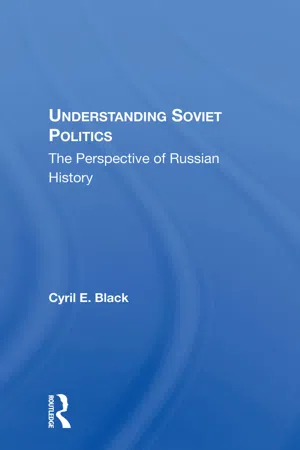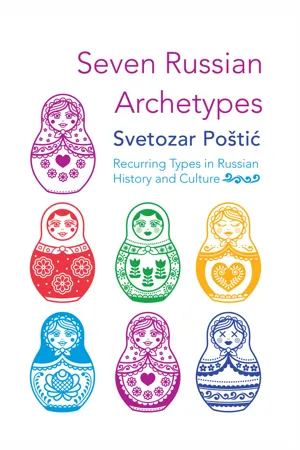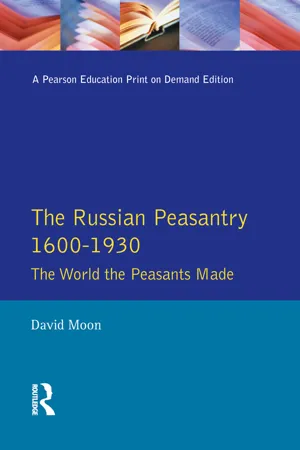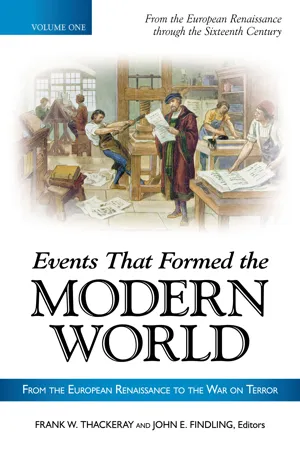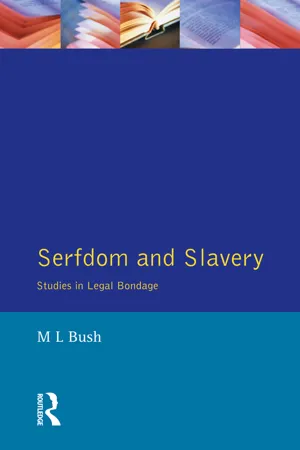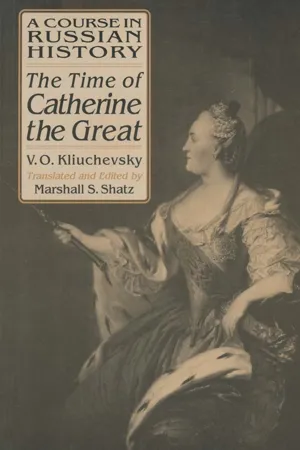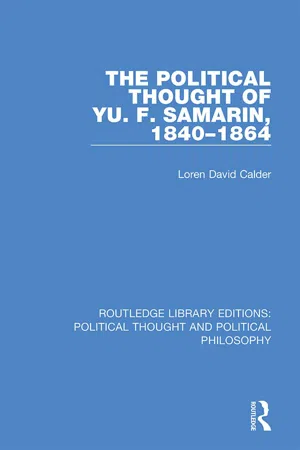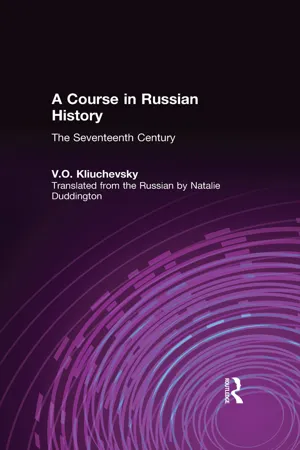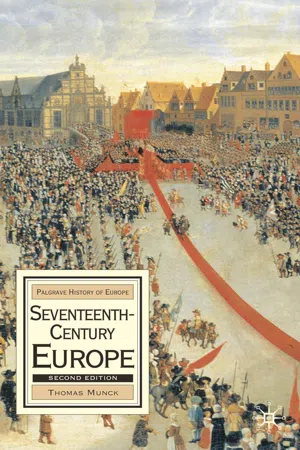History
Serfdom in Russia
Serfdom in Russia was a system of forced labor in which peasants were bound to the land and under the control of landowners. It was a central feature of the Russian economy and society from the 16th to the 19th centuries, with serfs having limited rights and facing harsh conditions. The system was eventually abolished in 1861.
Written by Perlego with AI-assistance
Related key terms
Related key terms
1 of 4
Related key terms
1 of 3
11 Key excerpts on "Serfdom in Russia"
- eBook - ePub
Understanding Soviet Politics
The Perspective Of Russian History
- Cyril E. Black(Author)
- 2020(Publication Date)
- Routledge(Publisher)
9The system under which the peasants were bound to the soil and to the noble landowner is known as serfdom, and it existed in its most rigorous form between 1649 and 1861. Russian serfdom must be distinguished from feudalism as it existed in Western Europe. Feudalism was a political system characterized by a contractual relationship between lord and vassal, whereas in serfdom the relationship was primarily economic and was based not on contract but on the edict of the sovereign. There had been elements of the lord-vassal relationship earlier in Russian history, but these had disappeared with the rise of serfdom.10 The state created serfdom as a means of assuring itself of a reliable source of revenue in a situation in which land was plentiful but labor was scarce, and agriculture was the principal source of income. The conditions of peasant life were so hard in Russia in the fifteenth and sixteenth centuries, because of the endemic civil strife and the increasing need of the state for revenue to meet the requirements of national defense, that the peasants tended constantly to escape to the south or east to avoid oppression. Various efforts were made to restrict the freedom of movement of the peasants, and these finally culminated in the middle of the seventeenth century in the imposition of a form of serfdom noted for its oppressiveness.11There were numerous and large-scale peasant revolts both before and after the imposition of serfdom, but in every case they were repressed. In the course of the two centuries during which serfdom was in force, the machinery of government underwent a fundamental transformation, the noble landowners won a substantial relaxation of their obligations to the state, and modest beginnings were made in the development of an industrial system. There was no comparable improvement in the status of the peasants, whether under the state, the crown, or the landlords, however, and in the case of the latter it tended to become more oppressive. This is not to say that the nobles benefited by the system either, for most of them were persons of limited means and they were increasingly going into debt during the first half of the nineteenth century. - eBook - ePub
Seven Russian Archetypes
Recurring Types in Russian History and Culture
- Svetozar Poštić(Author)
- 2023(Publication Date)
- Wipf and Stock(Publisher)
muzhik was the stagnant feudalist social and political arrangement of the Russian society, epitomized in the institution of serfdom. The social status of the Russian serf was perhaps only slightly higher than that of a slave, who had no legal rights and represented for all practical purposes a physical property of his master. Serfdom in Russia developed gradually in the early modern period, reached its peak in the seventeenth century, and was abolished, curiously, only a year and a half before American slavery. Its impact and consequences, although seemingly dissimilar, were on many levels comparable to the black bondage in the United States.As in most European countries, Serfdom in Russia developed step-by-step, but a few centuries later than elsewhere. Previously free farmers, communal peasants, and even private landowners started renting out plots of arable land from the landed nobility. In the Grand Duchy of Muscovy, local land tenure was acquired as a reward for military and civil service. The soil was cultivated by local peasants and ploughmen hired by landowners, who had to compensate the harvest of the crops for their own use by relinquishing part of the yield.Factual serfdom did not start in earnest until the end of the sixteenth century and the introduction of landowners’ rights to seek the peasants who departed without having paid their debt, which gradually spread to all tenants on the land. With the Sobornoe Ulozhenie (“Council Code”) of 1649 , the time period in which the landowner had the right to forcibly return the runaway peasants became unlimited, and even the debtless peasants were tied to their original place of residence.231 The nobility was granted the exclusive privilege of owning serfs in exchange for military duty. In 1675 , landlords were awarded the prerogative to sell peasants without a plot of arable soil. Finally, the serfs were effectively tied to the land with the introduction of the poll tax (literally “soul tax”—podushnaia podat’ ) in 1722 - eBook - ePub
The Russian Peasantry 1600-1930
The World the Peasants Made
- David Moon(Author)
- 2014(Publication Date)
- Routledge(Publisher)
Serfdom and the other means by which the state extracted a large part of the product of the labour from its mainly peasant population met this need. Together with all landowners, moreover, the state was concerned to maintain internal security against the threat of peasant revolts. Serfdom and restrictions on all peasant movement were ways to keep peasants under control. 8 By the early eighteenth century, the measures binding peasants to the land had led to the division of the Russian peasantry into categories according to the owners of the land they lived on. The main categories were: seigniorial (pomeshchich’i) peasants, or ‘serfs’, who lived on the estates of nobles; state (kazennye, gosudarstvennye) peasants, whose land was state property; church (tserkovnye, ekonomicheskie) peasants, who lived on lands belonging to the Russian Orthodox Church; and the smaller numbers whose landowners were members of the tsar’s family, known as court (dvortsovye) peasants until 1797, and thereafter as appanage (udel’nye) peasants. 9 The emergence of servile labour was not restricted to Russia. While serfdom had largely died out in north-west Europe by the sixteenth century, in addition to Russia it also developed in large areas of eastern and central Europe, including right-bank Ukraine, Belorussia, Lithuania and the Baltic provinces of Estonia, Livonia and Kurland, which were annexed by the Russian Empire in the eighteenth century. At roughly the same time, moreover, slavery was introduced to Europe’s American colonies. 10 PEASANTS’ OBLIGATIONS TO LANDOWNERS AND THE STATE (TO 1860 S) The enserfment of a large part of the Russian peasantry and similar restrictions on the rest of the peasantry greatly facilitated the exploitation of the mass of the rural population by the ruling and landowning elites - eBook - ePub
Events That Formed the Modern World
From the European Renaissance through the War on Terror [5 volumes]
- Frank W. Thackeray, John E. Findling, Frank W. Thackeray, John E. Findling, Frank W. Thackeray, John E. Findling(Authors)
- 2012(Publication Date)
- ABC-CLIO(Publisher)
8 The Emancipation of the Russian Serfs, 1861
Introduction
By the middle of the nineteenth century, the Russian Empire found itself in dire straits. For more than five decades, Russia’s leaders had neglected its domestic problems, and stagnation now characterized the state. Any attempt to revitalize Russia would have to begin with serfdom, a form of human bondage that had distinguished Russia for centuries. The Russian nobility owned not only the land, but also the peasants, or serfs, who worked the land. The royal family, the Russian Orthodox Church, and the state itself owned millions of serfs. Although there were laws on the books to mitigate the evils of serfdom, in practice Russian serfs differed little from American slaves save for the color of their skin. Estimates indicate that of a population totaling approximately 74 million in 1858, there were 23 million privately owned serfs; 25 million state peasants, or serfs, owned by the state or its appendages such as the church; and perhaps 2 million appanage serfs, or serfs owned by the tsar.An immense mass of ignorant, illiterate, isolated, superstitious humanity, the Russian serfs lived in grinding poverty. They had no civil liberties or human rights and found themselves at the mercy of their owners. Often sullen and noncooperative, the serfs resented their status but lacked the means to change it.Most serf holders preferred to perpetuate the status quo; however, by midcentury a growing number of Russians had concluded that serfdom needed to be reformed drastically if not eliminated entirely. Several factors led to this conclusion. For some, Russia’s gradual transformation from a feudal economy to a capitalist one demanded the end of serfdom. Free labor, one of the foundations of a capitalist economy, was more efficient and cost-effective than serf labor. Other Russians, especially those who had visited western Europe, supported emancipation for humanitarian reasons. For them, enserfment was not only barbaric and uncivilized, but also undermined Russia’s claim to be part of the European mainstream. - eBook - ePub
Foundations of Modern Slavery
Profiles of Unfree and Coerced Labor Through the Ages
- Caf Dowlah(Author)
- 2021(Publication Date)
- Routledge(Publisher)
Some studies also show that emancipation of serfs contributed to greater productivity gains and economic growth for Russia. Markevich and Zhuravskaya (2018), for example, found that Russian GDP increased by 18 percent in the second half of the nineteenth century, mainly because of the change in the incentive structure brought forth by serf-emancipation. The study found that gaining back the rights to own land and labor, peasants transformed themselves into free small-scale farmers, and exerted greater effort to adapt to local conditions and applied available agricultural knowledge and technologies better than before.E Concluding remarks
The Russian serfdom, that survived almost 400 years, thrived on a two-prong strategy: tying peasants to a parcel of land- and serf-owners, and empowering of the serf-owners to serve the monarchy. The nature of relationships between serfs and serf-masters, as well as between the nobles and monarchs, was consistently shaped by the same strategies. While a segment of serfs—especially state-serfs and those lived on imperial land—enjoyed greater latitude, for a vast majority of the serfs, the serfdom resembled chattel slavery—their mobility, productivity, education, and economic activities were severely restricted. Russian serfs could be bought and sold as any other property.The captive serf-labor force helped Russian economy to thrive agriculturally, and even helped Imperial Russia to emerge as a major power in Europe militarily, but the institutional regime of serfdom turned out to be fundamentally antithetical to economic development. The nation almost completely missed the boat of industrialization, urbanization, and modernization that flourished in Western Europe during the same the period. The Russia indeed ended up as an agrarian and backward economy when serfdom ran its course. While early disappearance of serfdom contributed to the rise of Western Europe and its transition to capitalism, long dependence on serfdom left Russia with a fertile background to make a transition to socialism. - eBook - ePub
Serfdom and Slavery
Studies in Legal Bondage
- M. L. Bush(Author)
- 2014(Publication Date)
- Routledge(Publisher)
The importance of serfdom is often assumed, but with what good reason? One view is to see it as a veil draped over the true face of rural society, obscuring its essential features. Thus, in eighteenth and nineteenth-century Russia, the mentality of the peasantry, it is argued, was conditioned not by serfdom but by other factors, notably the way authority was allocated within the commune and among its component families, the way relationships between lord and serf were determined by the collusion of family heads, and the way relationships between families within the commune were determined by the practice of repartitional tenure (Hoch). Within this scheme, serfdom played little part in determining the peasant outlook. On the other hand, without the coercion of serfdom, it is argued, the Russian peasantry would have been much less productive (Mironov). The importance of serfdom could also be questioned on the grounds that, within the peasant community, social divisions were created by the differences between rich and poor rather than by the distinction between those of free or unfree status.One means of stressing the importance of serfdom is to view it in class terms, especially by assuming that peasant societies which featured serfdom were dominated by it and therefore especially vulnerable to exploitation, so much so that, thanks to serfdom, the peasants’ advantage of possessing the means of production was denied and lords instead gained free access to their surplus and took full charge of their labour. However, in medieval serf societies the unfree formed only a minority (Dyer, Davies). In the modern period, serfs often formed the majority, but, outside Poland, Hungary and Bohemia, not usually an overwhelming one (Bush). Furthermore, the unfreedom of the serf was no bar to the possession of rights and the acquisition of wealth: the former, a protection against exploitation, the latter, proof of the effectiveness of these rights. Serfdom was presented by reformers in the eighteenth century as a cause of peasant impoverishment, but much depended upon the degree to which serfs were exposed to the demands of their lords and the crown. Studies of living standards and the weight of exaction, in both medieval and modern serf societies (Dyer, Hagen, Hoch), suggest that serfdom could serve the peasant as well as the lordly interest. Within the chain of exploitation, serfs were not at the bottom. As peasants, serfs were better off than landless labourers; and, protected by seigneurial custom or urbarial regulations, they were better off than those free peasants who were rack-rented, either because they leased demesne or because they held subleases of tenure land. Serfs were not downtrodden simply because of their servile condition; and lords were not necessarily free to do what they liked because their tenants were serfs. All this would suggest that explaining the condition of serfdom in class terms fails both to identify its true nature and to appreciate its pre-capitalist character (Hoch). - eBook - ePub
The Making of Modern Freedom
Slavery, Serfdom, and Free Labor
- Stanley L. Engerman, Stanley L. Engerman, Stanley L. Engerman(Authors)
- 1999(Publication Date)
- Stanford University Press(Publisher)
44 The increased autonomy made possible by emancipation, therefore, represented a less dramatic break with the past for Russian peasants than it did for American blacks.Indeed, many of the changes that occurred simply reinforced tendencies that already existed. When Russian noblemen abandoned the land, they were fulfilling the logical culmination of their longstanding absentee orientation; emancipation now enabled them to go one step further, and dispose of their landholdings entirely. Similarly, the increase in peasant stratification that followed emancipation represented not an entirely new phenomenon, but rather the accentuation of a longstanding pattern, for the relatively high degree of peasant autonomy had permitted considerable stratification even under serfdom.45 In short, there was a basic cultural continuity that survived many of the new departures; to oversimplify, one might suggest that whereas in the American South emancipation made it possible for blacks to strike out in new ways, in Russia emancipation made it possible for peasants to develop more fully many of their traditional ways.46Nowhere is this so evident as in the augmented authority of the mir, or village commune. Literally constituting the world of the peasants (“mir” means world and peace as well as commune), the mir was a pervasive peasant institution under serfdom, what one prominent historian has described as “the organizing basis of all village life.” Through it peasants ordered their lives and handled day-to-day problems. Through its elected representatives, the commune settled minor disputes among peasants, maintained a reserve of grain and money to help the needy in time of crisis, and determined who should be drafted into the army to meet the village’s quota of recruits. In most of Russia (but not in the Ukraine or Belorussia), the commune periodically reallocated peasant land allotments and obligations, to make sure that the burden was shared relatively evenly; everywhere, communal officials served, simultaneously, as the landowners’ lowest level estate administrators and as the peasants’ representatives in dealing with those landowners (and with the outside world in general). Noblemen—and the government as well—usually had little to do with individual peasants; instead, they dealt with them through the commune. Russian peasants lived, to a degree unknown by American slaves, highly communal lives.47 - Vasili O. Kliuchevsky, Marshall S. Shatz(Authors)
- 2015(Publication Date)
- Routledge(Publisher)
Catherine did not choose any of these methods. She simply consolidated the domination of the owners over their peasants in the form that it had assumed in the middle of the eighteenth century, and in some respects even broadened that power. As a result, serfdom under Catherine II entered a third phase of its development; it took a third form. The first form of serfdom, up to the decree of 1646, was personal dependence of the serfs on the landowners by agreement. This was the form in which serfdom existed until the middle of the seventeenth century. Under the Code of Laws of 1649 and Peter’s legislation, serfdom was transformed into the hereditary dependence of the serfs on the landowners by law, on condition of the landowners’ compulsory service. Under Catherine, serfdom assumed a third form: it turned into the complete dependence of the serfs, who became the private property of the landowners, but no longer on condition of the latter’s compulsory service, from which the nobility had been released. That is why Catherine can be called the perpetrator of serfdom—not in the sense that she created it, but in the sense that under her it was transformed from a variable fact, justified by the temporary needs of the state, into a right recognized by law but in no way justified.Now let us examine the consequences of serfdom in this, its third and last form. Those consequences were extremely varied. Serfdom was the hidden spring that moved and gave direction to the most diverse spheres of national life. It not only shaped the course of the country’s political and economic life but put a sharp stamp on its social, intellectual, and moral life. I will briefly enumerate some of the most notable consequences of serfdom and indicate first of all the effect it had on the landlords’ agriculture. For an entire century, from the manifesto of February 18 to the manifesto of February 19,2 our social, intellectual, and moral development proceeded under the weight of serfdom, and perhaps another whole century will elapse before our life and thought are freed from its traces.Under the shelter of serfdom, distinctive relationships and procedures took root in the landlord’s village in the second half of the eighteenth century. I will start with the methods by which landlords exploited serf labor.- Loren David Calder(Author)
- 2019(Publication Date)
- Routledge(Publisher)
CHAPTER VThe Laboratory of Serfdom
Vladimir Klyuchevsky described the peasant problem as “the most difficult question ever resolved by the Russian people in the whole course of their history.”599 The Great Emancipation of 1861 which ‘resolved’ the problem was described by Terence Emmons, a less illustrious but nevertheless competent present-day American historian, as “an epochal event in the life of the Russian state and … in the history of human bondage,” at one point, and at another, as “probably the most ambitious piece of social engineering in the history of modern Europe to the twentieth century.”600 The condition of serfdom abolished by emancipation was a rigid system of control over the peasants which had evolved over five centuries. At critical junctures in its evolution, such as 1497, when Ivan III restricted the peasants’ right to move, and 1649, when Tsar Alexis issued a statute placing the peasants in bondage, legislation was promulgated to confirm conditions which already existed in fact. By 1856 the iniquitous situation created by serfdom threatened a horrendous social catastrophe, so that the autocratic government of Axexander II acted deliberately to forestall it by legislative measures designed to establish entirely new conditions between landlords and peasants. Samarin and other enlightened and progressive noblemen like him, conscious of the inefficiencies and injustices of serfdom and fearful of a violent revolution if timely changes were not made, played an important role in drafting this legislation.601599 V.O. Klyuchevsky, “Krepostnoy vopros nakanune ego zakonodatel ‘nogo vozbuzhdeniya. Razbor vtorogo toma sochinepiy Yu. F. Samarina,” Sochineniya (Moscow, 1959) VII, 114.600 P.A. Zaionchkovsky, The Abolition of Serfdom in Russia- eBook - ePub
A Course in Russian History
The Seventeenth Century
- V.O. Kliuchevskii(Author)
- 2016(Publication Date)
- Routledge(Publisher)
In the sixteenth century the position of manorial peasantry as a social class contained three distinct elements: the payment of land tax, the right to leave, and the need for a loan from the master—that is, elements of political, juridical, and economic significance. Each of them was opposed to the other two, and the changing course of the struggle between them accounted for the hesitancy of legislation in defining the peasants’ status. The struggle was due to the economic factor. From the middle of the sixteenth century onward, for various reasons that we have partly considered, the number of peasants needing loans for starting and carrying on their farming began to increase. The need for loans compelled the peasants to remain in bondage and forfeit their right of free movement until they repaid their debts. This right was not abolished by law, but became a legal fiction. The argument against peasant bondage was that as freemen they paid a land tax, from which bondsmen were exempt; and so at the beginning of the seventeenth century legislation tried to prevent peasants from becoming bondsmen, and a law was passed establishing “peasant perpetuity,” which made it impossible for a peasant to escape the status of taxpayer. These aspects of the peasants’ position, combined with the conditions of personal bondage as it existed in ancient Russia, provided the legal framework for the enslavement of the manorial peasantry.In ancient Russian law the word “bond” denoted a symbolic or written deed entitling a person to the possession of a certain thing. The power conferred by such a deed gave the owner a bonded right to that thing. In ancient Russia human beings could be objects of possession. Bondage existed in ancient Russia for centuries before the introduction of peasant serfdom, and until the end of the fifteenth century there was only one form of it—“complete” bondage, as it came to be called later. It was brought about in various ways: (i) by captivity, (2) by a free person’s selling himself into servitude voluntarily or at his parents’ will, (3) as a penalty for certain crimes, (4) by being born of a bondsman, (5) as a penalty for insolvency due to the trader’s own fault, (6) by a free person’s engaging himself as a servant to another without a contract guaranteeing his personal liberty, (7) by marrying a bondswoman without such a contract. Not only did a “complete” bondsman depend on his owner and the owner’s heirs; he handed on this dependence to his children. The right of ownership and the bondage were both hereditary. The main feature distinguishing complete bondage from other kinds of dependence in the eyes of the law was that it could not be terminated at the bondsman’s will; he could become free only at the will of his owner. - eBook - ePub
Seventeenth-Century Europe
State, Conflict and Social Order in Europe 1598-1700
- Thomas Munck(Author)
- 2017(Publication Date)
- Bloomsbury Academic(Publisher)
Kölmer or yeomen, and as we have already noted there was scope for an economically autonomous peasantry and relatively free wage-labour in the environs of powerful cities like Königsberg. There were other variations: in Lithuania, although serfdom developed early, large-scale demesnes remained relatively few in number, while a small number of wealthy peasants actually increased their holdings in the course of the seventeenth century.Further south, especially in the more hilly parts of Silesia, southern Poland, Bohemia and Moravia, where grain was not so readily grown for bulk export, the development was very different. In Bohemia, for instance, the nobility had not traditionally demanded very large labour services because the seigneurial economy was orientated towards fish-farming, livestock-breeding, brewing and other specialised industries which were not so labour-intensive. During the sixteenth century, however, the growth of towns not only under royal protection but also on private noble land made market production more attractive. Even so, the consolidation of enclosed estates and demands for compulsory peasant labour services remained for a time limited by comparison with northern Germany, and the legal and personal restraints of serfdom were not exploited very fully. It was the military defeat of the Thirty Years War, and the changes in landownership from the 1620s onwards, that seem to have brought the most marked deterioration in peasant conditions in Bohemia. Seigneurs assumed stronger repressive powers to deal with the consequences of wartime devastation, and emphasised restrictions on peasant mobility to compensate for population losses. The peasant revolts of the later 1620s (see chapter 1 ) were repressed with brutality, and the constitutional changes wrought by the Habsburgs destroyed the vestigial legal and personal rights of the peasantry. Labour services (robota
Index pages curate the most relevant extracts from our library of academic textbooks. They’ve been created using an in-house natural language model (NLM), each adding context and meaning to key research topics.
Explore more topic indexes
Explore more topic indexes
1 of 6
Explore more topic indexes
1 of 4
